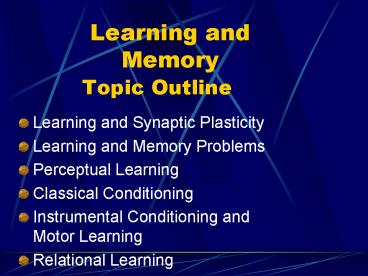Learning and Memory Topic Outline - PowerPoint PPT Presentation
1 / 34
Title:
Learning and Memory Topic Outline
Description:
Learning involves changes in the nervous system. Physical/chemical ... cortex: sharpens tone detection ... Tone: activates cells in the medial geniculate ... – PowerPoint PPT presentation
Number of Views:53
Avg rating:3.0/5.0
Title: Learning and Memory Topic Outline
1
Learning and Memory Topic Outline
- Learning and Synaptic Plasticity
- Learning and Memory Problems
- Perceptual Learning
- Classical Conditioning
- Instrumental Conditioning and Motor Learning
- Relational Learning
2
Learning
- ...relatively permanent changes in behavior
produced by experience - Learning involves changes in the nervous system
- Physical/chemical
- Learning allows us to tailor our behaviors to the
environment allows for adaptation - Learning involves the motor, sensory, and memory
systems - Lashleys engram- physical representation of
memory
3
Forms of Learning
- Perceptual identify objects and situations
- Stimulus-Response connections between stimuli
and motor responses - Classical conditioning
- Operant Conditioning
- Motor form new circuits in motor system
- Relational identify connections between stimuli
4
Classical Conditioning
- Involves making connections between two forms of
stimuli - Unconditional (US) reliably provokes a response
- Response is termed unconditional (UCR)
- Conditional (CS) neutral does not provoke the
response - Pair the CS and UCS over many trials
- Does the CS alone produce a response?
5
Video The locus of learning and memory
6
The Hebb Rule
- Hebb argued that synapses that are active at the
same time that the postsynaptic neuron fires are
strengthened over time - Implies physical changes in the nervous system
- Rosensweig enriched environment studies
- Noted specific changes in brains of enriched rats
- Thicker cortex
- More glial cells
- More Ache (perhaps more ACh?)
7
(No Transcript)
8
Video Learning as synaptic change
9
Long-Term Potentiation
- Cells in entorhinal cortex project via perforant
path to synapse onto granule cells in the dentate
gyrus - LTP procedure electrically stimulate perforant
path (100 pulses/over a few seconds) - Then observe postsynaptic potential induced by a
single pulse given repeatedly over days - LTP is indexed by gradual increase in PSP size
10
(No Transcript)
11
(No Transcript)
12
Long-Term Potentiation
- LTP requires
- Activation of synapses and depolarization of
postsynaptic membrane - LTP involves
- Release of glutamate
- Activation of NMDA receptors in depolarized
membrane - Entry of calcium ions
13
(No Transcript)
14
Mechanisms of LTP
- LTP may result from
- Increased release of transmitter
- Increased number of receptors
- Greater linkage of receptors to ion channel
openings - Increased number of synapses
- Other causes?
14.11
15
(No Transcript)
16
Glutamate releaseNMDA receptorsNon-NMDA
rec.Calcium entryNO feedback onto presynaptic
cell
A Biochemical Model of LTP
17
Video Living with amnesia
18
Pathologies of Memory
- Amnesia vs. forced memories
- Review of cases
- Korsakoffs
- Alzheimers- video later in course
- Concussion
- ECS
19
Video memory strategies from an expert.
20
Perceptual Learning
- Learning about simple perceptual objects occurs
in association cortex - Visual perceptual learning
- Ventral stream what object issues
- Ability to differentiate visual patterns requires
intact connections between visual cortex and
inferior temporal cortex - Dorsal stream where object issues
- PET studies document ventral/dorsal stream
activation during object- and spatial-memory tasks
21
(No Transcript)
22
Role of ACh in Learning and Memory
- Deutsch noted that anticholinergic drugs impair
learning in animals and humans - Alzheimers disease involves memory loss
- Damage to ACh cells in Alzheimers disease
- Nuc. Basalis--gt neocortex
- Medial septum--gt hippocampus
- Footshock induces ACh release in auditory cortex
sharpens tone detection
23
Classical Conditioning
- Footshock (FS) activates cells in basolateral
amygdala--gt activates central amygdala - Central amygdala--gt freezing, autonomic changes
- Tone activates cells in the medial geniculate
- CER learning Tones paired with FS come to
elicit freezing - May be due to LTP-like processes in thalamus,
amygdala - CER is blocked by AP5 (NMDA antagonist) in
amygdala
24
Reinforcement
- Olds and Milner study
- Electrical stimulation of rat brain induces
reinforcement - Responses that produce brain stimulation are
repeated (e.g. bar press, alley running) - Dopamine plays a critical role in
self-stimulation - Mesolimbic dopamine system
- Ventral tegmentum to accumbens, amygdala, septum
- Mesocortical dopamine system
25
(No Transcript)
26
Nuc. Accumbens and Reinforcement
- Self-stimulation is supported by electrodes
placed along mesolimbic path - Rats will self-inject dopamine agonists directly
into the nuc. accumbens - Natural reinforcers increase extracellular
dopamine levels in nuc. accumbens - Microdialysis studies
- Drugs of abuse also increase DA release
27
(No Transcript)
28
DA and Motivated Behaviors
- Natural and conditioned reinforcers may act via
stimulating DA release in the nuc. accumbens - Conditioned punishers may reduce DA in nuc.
accumbens - Mark et al (1989) after CTA learning, saccharin
taste reduces DA level in nuc. accumbens
14.18
Carlson - Physiology of Behavior 6/e, Allyn and
Bacon
29
(No Transcript)
30
(No Transcript)
31
(No Transcript)
32
Long and Short Term Memory
- STM- (working memory)
- limit is about 7 items.
- Once lost its gone for good.
- Can be selectively impaired.
- Prefrontal cortex
- LTM-
- Unlimited
- Can recall with effort and clues
- Can be selectively impaired
- Distributed storage
33
Role of Brain areas in Memory
- Rhinal cortex-medial temporal cortex formation
of LTM for objects - Hippocampus consolidation of LTM for spatial
locations - Amygdala emotional content?
- Association cortex memory storage?
34
Role of Brain areas in Memory
- Cerebellum motor learning
- Prefrontal cortex temporal order of events
- Dorsal medial thalamus linked with medial
temporal lobe - Basal forebrain many functions, not just memory































